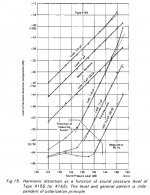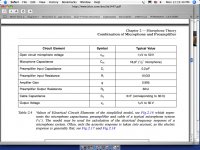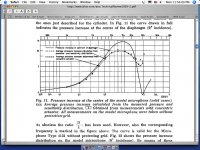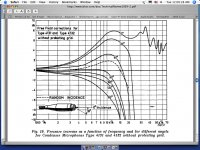If you want to be helpful, find the equation for distortion from a mike capsule with a varying capacitance under vibration against a fixed load capacitance.
Here are the measurement results from bktr79-4
Attachments
Here are the measurement results from bktr79-4
I think this is what John wants. B&KTR 96-1
Reduction of Non-linear Distortion in Condenser Microphones by Using
Negative Load Capacitance ...................................................................... 19
by Erling Frederiksen
It contains a full mathematical derivation of distortion as related to load capacitance, with verification by mechanical measurements.
Once again: This is WHERE I got my first insight. Mead got it from earlier work, so what?
Johnson's derivation of the noise of an RC network is taught by sophomore year, so what?
I think this is what John wants. B&KTR 96-1
Reduction of Non-linear Distortion in Condenser Microphones by Using
Negative Load Capacitance ...................................................................... 19
by Erling Frederiksen
It contains a full mathematical derivation of distortion as related to load capacitance, with verification by mechanical measurements.
You can find this paper included in Technical Review 1 (1996), "Calibration Uncertainties & Distortion of Microphones," available on B&K's site.
Wavebourn, resistors have capacitance too. Earling Fredrikson told me himself that this was the reason when I visited B&K in 1974.
However, if they were dealing with high parasitic capacitance of resistors, they were right. Were they multilayer?
As I've mentioned a couple of times, in other posts and threads, it's all about the implementation of the circuitry of the D/A converter and surrounding analogue elements. The "fantasy" of the digital engineers is that because under very precise test conditions the circuit behaves itself, it comes up with the "correct", very low distortion figures that this will perfectly transfer to the real world. Sorry, it ain't happening -- I, and many others have been fighting this audio myth for many, many years; it's why digital sound has got such a bad name for itself.Now, why higher (than 88.2 which is min to preserve what current mics can acquire, at least those from 2L) sampling rate sounds better if the HF content is the same?
Somebody said earlier in this thread "noise", and I agree - pushing the hf noise further makes it less audible (by whichever mechanism the ear/brain use).
So, virtually all digital implementations are audibly flawed, and then the trick is how to get around this. One answer, which I've found works very nicely, is to simply resample to a higher rate; in a low cost, nothing special DAC environment it always improves the sound. You're saying that hf noise is less audible; I would say that the electronics are adding less audible distortion to the sound because the implementation failings have less impact.
Frank
Last edited:
No, I'm not getting more information, from the digital file. My exercise with the resampling demonstrates that doing those sorts of fiddles in most cases does not alter the audio-relevant information in the file.Fas42,
Could you point me to an article that explains how by re-sampling you are getting more information than was in the original sample? Not quite following how this works.
However, by changing the way the audio file is fed to the DAC you can change how it sounds. Because, the level and type of distortion generated in the analogue side of things alters. So, first you have be convinced that there is no magic imperviousness of the analogue circuitry to interference effects, just because the source is digital; I can do that very easily for myself by bringing an active mobile or cell phone near the DAC area: if the system is half decent you should be able to hear the effect, which is not to inject very audible bleeps and rasping sounds, but rather is to dull, add a grey murkiness to the sound. The typical complaint a lot of people have about digital sound, in other words.
So, if you can hear this happening, then it's only a short step to realise that if you alter the high frequency signature of electrical behaviour in the area of the DAC, by changing the rate at which digital data is retrieved and fed to the DAC, then the sound will also change. Ultimately, it's all about a type of distortion where very little effort has been made to thoroughly understand it.
NOS DACs "win" because the amount of high frequency electrical activity overall is much less than for, say, S-D. Less high speed circuitry, better sound, is a very rough, general guide ...
Frank
Last edited:
Supersonic SACDs?
Gentlemen, I've lost the link to the 2L free download page. Could someone please repost it.
Frank, can you tell me which of the 2L recordings you have downloaded? I don't want to repeat your work though I only want to see if the ultrasonic stuff on their recordings is 'musical' or just noise.
Anyone with opinions of which ones will show off the ultrasonic content?
So far we only have a few Telarc SACDs suggested by Pavel.
Gentlemen, I've lost the link to the 2L free download page. Could someone please repost it.
Frank, can you tell me which of the 2L recordings you have downloaded? I don't want to repeat your work though I only want to see if the ultrasonic stuff on their recordings is 'musical' or just noise.
Anyone with opinions of which ones will show off the ultrasonic content?
So far we only have a few Telarc SACDs suggested by Pavel.
No, I'm not getting more information, from the digital file. My exercise with the resampling demonstrates that doing those sorts of fiddles in most cases does not alter the audio-relevant information in the file.
However, by changing the way the audio file is fed to the DAC you can change how it sounds. Because, the level and type of distortion generated in the analogue side of things alters. So, first you have be convinced that there is no magic imperviousness of the analogue circuitry to interference effects, just because the source is digital; I can do that very easily for myself by bringing an active mobile or cell phone near the DAC area: if the system is half decent you should be able to hear the effect, which is not to inject very audible bleeps and rasping sounds, but rather is to dull, add a grey murkiness to the sound. The typical complaint a lot of people have about digital sound, in other words.
So, if you can hear this happening, then it's only a short step to realise that if you alter the high frequency signature of electrical behaviour in the area of the DAC, by changing the rate at which digital data is retrieved and fed to the DAC, then the sound will also change. Ultimately, it's all about a type of distortion where very little effort has been made to thoroughly understand it.
NOS DACs "win" because the amount of high frequency electrical activity overall is much less than for, say, S-D. Less high speed circuitry, better sound, is a very rough, general guide ...
Frank
If a CD player outputs 44,100 words per second along it's digital output, how many words does the DA have to decode? (per second)
What is the accuracy of the CD clock that is producing the words?
What is the accuracy of the DA's receive clock?
How do you make sure that they match?
This is what I call a design for a flat random-incidence response. To be used far field. Thx-RNMarshThis goes with previous graph:
JC, are you now claiming that having advised B&K, Ampex and a zillion other incompetent engineers how to do better, ...This goes with previous graph:
... that your Jurassic circuits which far exceed Scott's designs in noise, distortion & sheer musicality ....
... also miraculously compensated for the directivity of a rigid piston at the end of a tube?
I have some small interest in the subject as the Mk4 Soundfield is a better omni than a 1/2" B&K up to 10kHz.
- Status
- Not open for further replies.
- Home
- Member Areas
- The Lounge
- John Curl's Blowtorch preamplifier part II



